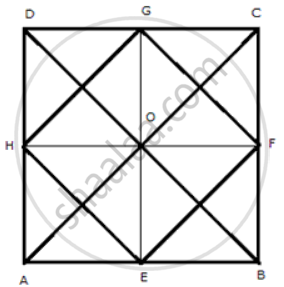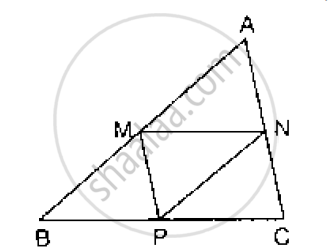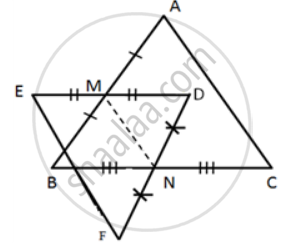Advertisements
Advertisements
Question
Show that the quadrilateral formed by joining the mid-points of the adjacent sides of a square is also a square.
Solution

Join AC and BD
In ΔACD, G and H are the mid-points of DC and AC respectively.
Therefore, GH || AC and GH = `(1)/(2)"AC"` ......(i)
In ΔABC, E and F are the mid-points of AB and BC respectively.
Therefore, EF || AC and EF = `(1)/(2)"AC"` ......(i)
From (i) and (ii)
EF || GH and EF = GH = `(1)/(2)"AC"` .........(iii)
Similarly, it can be proved that
EF || GH and EH = GF = `(1)/(2)"BD"` .........(iv)
But AC = BD ...(diagonals of a square are equal)
Dividing both sides by 2,
`(1)/(2)"BD" = (1)/(2)"AC"` (iv)
From (iii) and (iv)
EF = Gh = EH = GF
Therefore, EFGH is a parallelogram.
Now in ΔGOH and ΔGOF
OH = OF ...(diagonals of a parallelogram bisect each other)
OG = O ...(common)
GH = GF
∴ ΔGOH ≅ ΔGOF
∴ ∠GOH = ∠GOF
Now,
∠GOH +∠GOF = 180°
⇒ ∠GOH + ∠GOH = 180°
⇒ 2∠GOH = 180°
⇒ ∠GOH = 90°
Therefore, diagonals of parallelogram EFGH bisect each other and are perpendicular to each other.
Thus, EFGH is a square.
APPEARS IN
RELATED QUESTIONS
In Fig. below, M, N and P are the mid-points of AB, AC and BC respectively. If MN = 3 cm, NP = 3.5 cm and MP = 2.5 cm, calculate BC, AB and AC.

ABC is a triang D is a point on AB such that AD = `1/4` AB and E is a point on AC such that AE = `1/4` AC. Prove that DE = `1/4` BC.
Prove that the figure obtained by joining the mid-points of the adjacent sides of a rectangle is a rhombus.
In the given figure, M is mid-point of AB and DE, whereas N is mid-point of BC and DF.
Show that: EF = AC.
The side AC of a triangle ABC is produced to point E so that CE = AC. D is the mid-point of BC and ED produced meets AB at F. Lines through D and C are drawn parallel to AB which meet AC at point P and EF at point R respectively.
Prove that:
- 3DF = EF
- 4CR = AB
In triangle ABC, D and E are points on side AB such that AD = DE = EB. Through D and E, lines are drawn parallel to BC which meet side AC at points F and G respectively. Through F and G, lines are drawn parallel to AB which meets side BC at points M and N respectively. Prove that: BM = MN = NC.
In ΔABC, D, E, F are the midpoints of BC, CA and AB respectively. Find FE, if BC = 14 cm
In ∆ABC, AB = 5 cm, BC = 8 cm and CA = 7 cm. If D and E are respectively the mid-points of AB and BC, determine the length of DE.
P, Q, R and S are respectively the mid-points of the sides AB, BC, CD and DA of a quadrilateral ABCD in which AC = BD. Prove that PQRS is a rhombus.
D, E and F are respectively the mid-points of the sides AB, BC and CA of a triangle ABC. Prove that by joining these mid-points D, E and F, the triangles ABC is divided into four congruent triangles.
